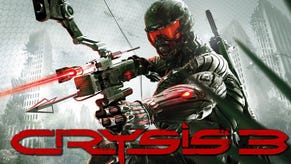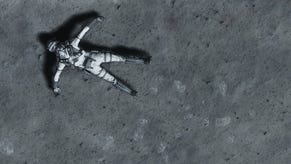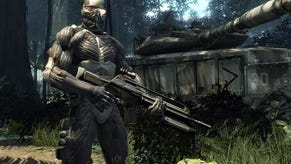Face-Off: Crysis
Can consoles run Crysis? Digital Foundry presents a triple-format analysis.
| - | Xbox 360 | PlayStation 3 |
|---|---|---|
| Download/Install Size | 4.1GB | 3.7GB |
| Surround Support | Dolby Digital | Dolby Digital, DTS, 5.1LPCM, 7.1LPCM |
A few days prior to its XBLA and PSN release, Crytek president and director Cevat Yerli declared with confidence that "when I say the console versions look better than Crysis on PC, I mean that as a factual thing, not in terms of technical specifications."
It speaks to Crytek's technological foresight that, even four years after its original PC release in 2007, Crysis is still considered a popular choice of benchmark among enthusiast gamers in the wake of a rig overhaul. It's also remarkable that the search for the coveted 1080p60 grail is still an ongoing pursuit for the many who are just a bit too strapped for cash to afford the likes of, say, a Core i7 processor in conjunction with a behemothic GTX 580. The release of mods in recent years has helped lighten the burden perhaps, with some allowing for a more optimised recreation of its highest settings by means of minor level-of-detail (LOD) streaming tweaks, or even full-fledged texture packs, but these can only do so much for certain set-ups.
With this in mind, the suggestion that a perceptible visual improvement is at all possible on hardware that pre-dates Crysis' original launch by over a year comes as a rather audacious claim and is sure to have PC gamers folding their arms and cocking their eyebrows quizzically. Those already playing the console versions, however, will appreciate that the philosophy behind this release has more in line with a meticulous remastering project than that of a quick and dirty port. It must be stressed that this is very much the Crysis you know and love, with all the bells and whistles attached, and the very fact that it runs on consoles at all is a cause for celebration in itself.
Much of the good work here has been helmed by Crytek's newly fashioned UK studio (formerly Free Radical), and it's a surprise that they've gone to the effort of even overhauling certain assets, such as ground and rock textures, during the game's transition from CryEngine 2 to CryEngine 3. This makes direct comparisons between the console version and equivalent settings on PC ineffective in many cases, so instead, we've gone for the no-holds barred approach in our Crysis triple format comparison gallery and head-to-head video.
The rules are simple enough: patched up to Version 1.21, we're running Crysis at 1280x720 on PC to match the 360 version's 1152x720 internal framebuffer as best we can, albeit mercilessly reinforced by 8x multi-sample anti-aliasing (MSAA). Meanwhile, Very High settings are selected across the board in the graphics options menu, with absolutely no mods or custom tweaks in play - to make this a "fair" test, the game must be running in the best case scenario, within all the original parameters laid out by Crytek. If the console versions do indeed look better, this is the standard to beat. For those interested, an equivalent Crysis PlayStation 3 vs. PC comparison is also available.
Expectations are, of course, that the PC version should absolutely, unquestionably trump it in every regard, but it would be rather dull if this were the case. Outside of the narrowed field of view and cooler overall colour temperature, there are clear, tangible differences to both console versions' visual make-up which can reasonably count as improvements. This is for the most part due to CryEngine 3's updated feature-set, with a revamped lighting model now allowing for more lighting sources, and the use of deferred cube map probes to calculate high-dynamic range reflections on every surface. Looking along the sandy coastline in the Recovery level, the effect reveals itself as a soft, glistening effect across the ground as you run in the direction of the sun, creating the illusion that each individual grain of sand is refracting light. A pleasant touch.

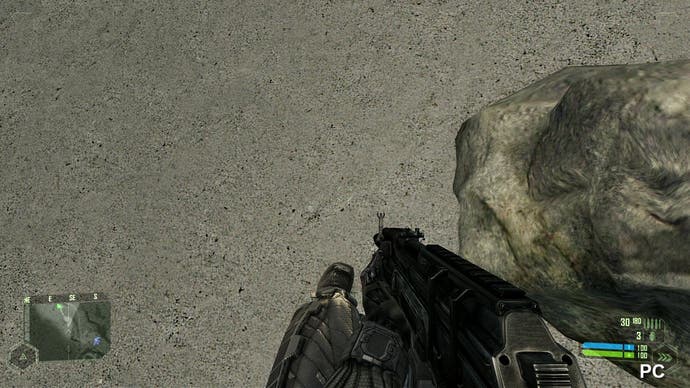
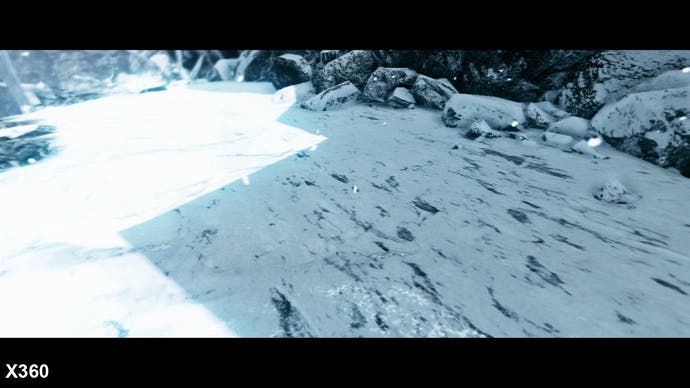
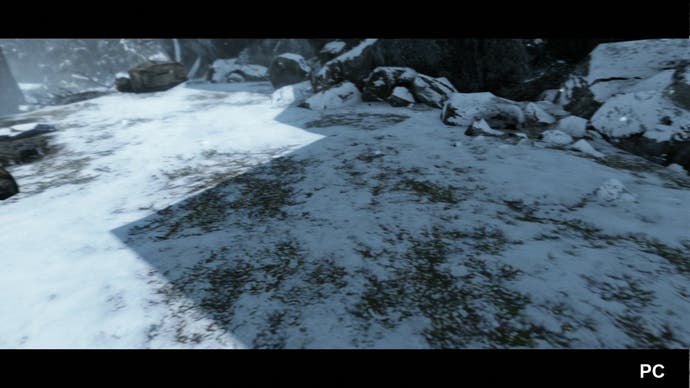

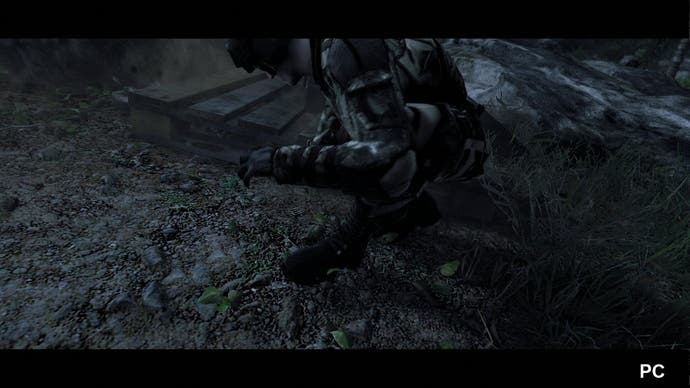
The actual changes to the lighting are intriguing: as you can see from the comparison sequences from indoors areas, the move to deferred lighting has resulted in a dramatic improvement - what's especially noticeable is how much more naturally the characters sit within the scene. However, in other areas, there's a feeling that the lighting has been unnaturally maxed - for example, the initial parachuting episode is very bright indeed, and you have to wonder if moonlight alone could account for such a bright look to the scene. Overall though, the effect is very pleasing if somewhat blue in many situations.
But what of textures? Although still a marvel to behold for the most part, the PC version has been criticised for its use of some glaring, low resolution textures in places, even on the highest setting, which can give the game an inconsistent look. While much of the texturing quality on consoles mixes assets from the Medium and High quality settings on PC, there are surfaces which have been tweaked for a cleaner, if not technically superior, look while still respecting the imposing RAM restrictions. When compared side-by-side with the best that the PC can offer, however, these limitations on console can show an inevitable disparity.
On the plus side, some of the more demanding visual effects on the PC version have been faithfully maintained: in particular, parallax occlusion mapping makes the cut for consoles, allowing for a 3D pop effect to large textured objects. This works by resolving the perspective of lighting on a texture through a displacement map, rather than creating more complex and demanding geometry. Strangely, the effect is prominent in places where previously there was no such definition, suggesting more on-the-sly tweaking by Crytek UK on consoles.
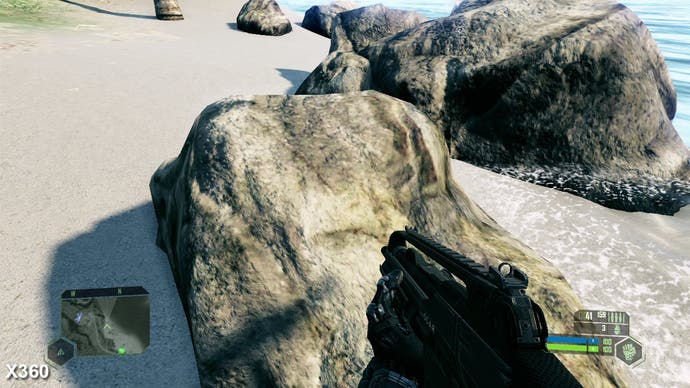

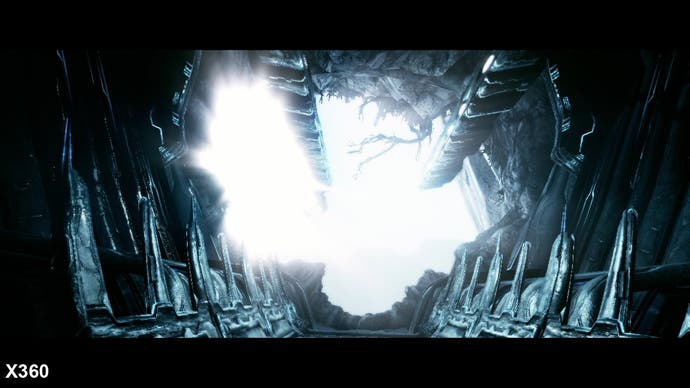

Factoring high quality shadows into the 360 and PS3's processing cycles, on the other hand, has not proven to be a priority. Although barely noticeable throughout more action-packed sequences, dithering is apparent during indoor settings with low light sources, and can be something of a distraction in cut-scenes. Additionally, a flickering effect can also be seen on animated textures, particularly while panning the camera across water, caused by a slower update on animated textures such as the crashing waves, or even after shooting small branches on trees.




